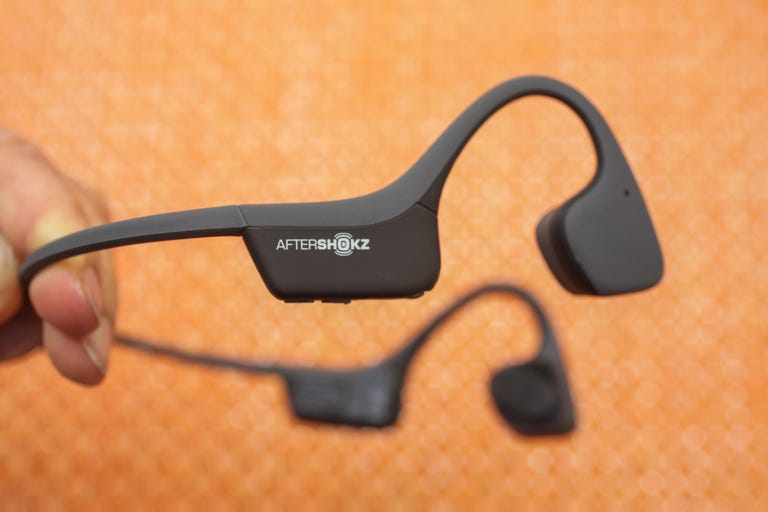 Why You Can Trust CNET
Why You Can Trust CNET AfterShokz Trekz Air review: AfterShokz Trekz Air: The best bone-conduction headphone yet
The new, slimmer version of the Trekz Titanium wireless headphone is more comfortable and sounds slightly better than its predecessor.
Truth be told, I haven't reviewed a bone-conduction headphone for several years. The reason for that was the early models I tested from AfterShokz sounded so bad it was hard to recommend them to anyone. But AfterShokz's designs and technology have come a long way since then, and its new $150 (£150) Trekz Air is a compelling wireless sports headphone. It doesn't appear to be available in Australia, but the US price translates to around AU$195.
The Good
The Bad
The Bottom Line
In case you don't know what a bone-conduction headphone is, it's one that delivers sound through your cheekbones. That's right: The headphone driver doesn't go in your ears or cover them; instead, it sits directly in front of them, resting on your face.
The slimmer Trekz Air is 20 percent lighter than the Trekz Titanium.
The big benefit of the technology is that thanks to its open design, you can hear what's going on around you while listening to music or having a phone conversation through the headphone. That openness allows runners and bikers to hear traffic, an important safety feature. Also, some race coordinators don't allow you to wear anything in your ears, which is where a headphone like the Trekz Air comes in handy, particularly for people who need to listen to music while they run.
The Trekz Air is the trimmed-down sequel to the well-received Trekz Titanium. It's 20 percent lighter than the Titanium, weighing 29.5 grams, and more comfortable to wear (its frame and wraparound band also incorporate titanium into their structure).
There are some buttons on the right side that let you control playback and volume. They're pretty small and a little hard to operate by feel, but they're there and do work.
They sit securely on your cheekbones.
I'm not going to tell you the headphone sounds great because it doesn't -- comparatively speaking, anyway -- but it sounds a whole lot better than those early AfterShokz models I tested. You're still not going to get really rich, immersive sound with good clarity and strong bass. The sensation is more like listening to good background music from speakers you can't see. It's both in your head and not in your head, if that makes any sense.
I'm partially making the reference to background music because you can only crank up the volume so high before you start feeling the sound vibrate on your cheekbone, which can be a little disconcerting. I kept the headphone at about 75 percent volume -- or right to the point where I started to feel a vibration. That volume level was adequate but a standard in-ear headphone will sound louder.
It's worth noting that the headphones do come with a set of foam earplugs that you jam into your ears. By blocking your ears the sound you get from the headphones not only becomes louder but improves overall, the bass in particular. But the majority of people probably aren't going to bother with the earplugs when they use this headphone.
Ultimately, the Trekz Air isn't for everyone, and will disappoint folks who prioritize sound quality. But the people who like it will like it a lot. While it doesn't offer a big upgrade in sound over the Trekz Titanium, it does sound better and is significantly more comfortable to wear (bikers can wear it with a helmet without a problem). It's a very likable sports headphone, particularly for people who want a secure fitting headphone that doesn't cover or prod their ears.
A nice carrying case is included.
The Trekz Air's key features, according to AfterShokz:
- Durable and flexible titanium Frame and wraparound band
- OpenFit design allows you to tune in to your music or a call without tuning out the world around you
- PremiumPitch+ technology optimizes the sound and includes additional features like LeakSlayer technology, which helps eliminate sound leakage
- Sweat-resistant (IP55 rated to repel sweat, moisture and dust)
- Six hours of battery life for music calls
- Fully charges in an hour and a half, but a 15-minute charge provides enough boost to "get you through a long workout or marathon call"
- Dual noise-canceling mics help reduce surrounding noise and enhance speech clarity
- Voice Prompts guide you through power, pair, play and talk and more
- Improvements over Trekz Titanium: Reduced sound leakage, improved dual noise canceling mics, new antenna for improved
Bluetooth
connection, resigned bone conduction transducers deliver more bass
- Price: $150 (£150, roughly AU$195) -- available now


